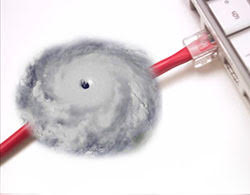Malware Infections Drop in Hurricane-Ravaged Areas as People are Forced Offline
 Computer malware infections in Texas and Florida took a dramatic drop in the days surrounding the arrival and devastation of Hurricanes Harvey and Irma. The significant drop in malware infections in the areas hit by Hurricane's Harvey and Irma is a sign that millions of computer users spent a lot less time on their computers during and after those storms. That's according to data released today by Enigma Software Group (ESG), makers of the anti-malware software SpyHunter. ESG looked at malware detection data from SpyHunter focusing in Houston, Texas and Miami, Florida in the days leading up to, during, and after the two devastating hurricanes that hit. Here's what we found.
Computer malware infections in Texas and Florida took a dramatic drop in the days surrounding the arrival and devastation of Hurricanes Harvey and Irma. The significant drop in malware infections in the areas hit by Hurricane's Harvey and Irma is a sign that millions of computer users spent a lot less time on their computers during and after those storms. That's according to data released today by Enigma Software Group (ESG), makers of the anti-malware software SpyHunter. ESG looked at malware detection data from SpyHunter focusing in Houston, Texas and Miami, Florida in the days leading up to, during, and after the two devastating hurricanes that hit. Here's what we found.
Malware Threats Decreased in Houston, TX from Hurricane Harvey
- Between August 28-30, when flooding from Harvey was at its worst, malware infections on computers in Houston dropped 26.2% from the average number of infections in the week before.
- One day, August 29th, saw the most dramatic drop in infections with a 52.5% drop from the average.
Malware Threats Decreased in Miami, FL from Hurricane Irma
- Infections began dropping from their usual levels starting on September 6th, as Irma was declared a Category 5 hurricane near Puerto Rico. Infections on the 6th dropped 49.1% over the average.
- Infections continued to drop until bottoming out on September 10th, when Irma hit mainland Florida. On September 10th, ESG detected just a handful of infections in all of Miami, a drop of 89.3% over the average.
- Overall, in the five days between when Irma was declared a Category 5 hurricane and when Irma hit Miami, infections were 48.8% lower than normal.
ESG spokesperson Ryan Gerding says there were likely two big reasons for the drop. "First, people simply lost access to their usual online activity," Gerding says. "Either because of massive power outages, flooding, or evacuations, there was simply no way for them to be online engaging in the typical activity that results in infections on their computers. Second, those who may have had online access were focused on other things and staying away from their computers. Those people were helping friends, helping family, helping neighbors, and just didn't have the time or interest to sit down at their computers and get online."
This isn't the first time that dramatic weather activity has impacted people's lives enough that it changed the level of malware infections. ESG has consistently found that during major snowstorms, when folks are forced to stay at home because of road conditions and work and school cancellations, malware infections almost always spike. The more time people spend online, the more often they are at risk for malware infections.
"As people begin to go back to their homes, get power turned back on, and resume some sense of normalcy, we're fairly certain those infections will return to pre-hurricane levels," Gerding said. "In fact, in both Houston and Miami we've already seen infections slowly start to climb as the water recedes and power is returned. So it's important for everyone, those in the hurricane areas and elsewhere, to always remain vigilant when they are online."